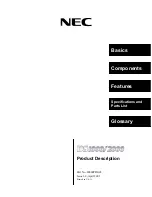
14
User's Guide ADI-192 DD © RME
5. Front panel Controls
5.1 INPUT MONITOR
The status of the inputs is displayed by 19 LEDs. The section INPUT MONITOR helps to avoid
errors caused by wrong, missing or not correctly connected inputs, and makes handling the
digital formats much easier.
General
Each input has its own SYNC LED. If a valid input signal is applied, SyncCheck is active auto-
matically. When more than one input signal is present, the input with the lowest number serves
as reference. SyncCheck takes the chosen clock (internal, external, etc.) as reference and com-
pares it with the input clocks. Inputs which are not synchronous will be signalled by flashing of
the corresponding SYNC LED.
The LEVEL LED lights up as soon as the digital signal carries an information other than digital
zero. The channel doesn't matter. So with ADAT there is only one channel of audio information
necessary for the LED to light up. The amount of level is not indicated.
AES
An AES/EBU or SPDIF signal in the range of 60 kHz to 100 kHz will turn the DS (Double
Speed) LED on. An AES/EBU or SPDIF signal in the range of 162 kHz to 200 kHz will turn the
QS (Quad Speed) LED on.
ADAT
An ADAT signal with S/MUX signalling will let the DW (Double Wire) LED light up. Unfortunately
this information is insufficiently standardised, and is even set falsely from several devices.
Therefore the DW LED is just a user information, but does not cause any action in the ADI-192
DD. Devices from RME always send out a correct signalling.
5.2 SRC INPUT
The button SRC INPUT SOURCE defines the data path in which the sample rate converter will
be inserted: AES, TDIF or ADAT. With no LED lit, the SRC is deactivated. Selecting the same
input in the OUTPUT section as in the SRC INPUT SOURCE section, the LED SRC indicates
an activated sample rate conversion. Selecting the function SRC in the OUTPUT sections is not
necessary.
In many input formats, the input signal's effective sample rate stays unclear because of possible
sample multiplexing
. Therefore the frequency range has to be defined manually with the
RANGE button:
No LED (Single Speed)
The effective sample frequency is in the range of 32 kHz up to 48 kHz.
DS (Double Speed)
The effective sample frequency is in the range of 64 kHz up to 96 kHz.
QS (Quad Speed)
The effective sample frequency is in the range of 176.4 kHz up to 192 kHz.
DS + QS (Multi-range Mode)
The effective sample frequency is in the range of 32 kHz up to 192 kHz. Note: keep the RANGE
button pressed to activate this mode. Only Single Wire input signals are supported. Can only be
activated when AES is selected.
Summary of Contents for ADI-192 DD
Page 4: ...4 User s Guide ADI 192 DD RME...
Page 5: ...User s Guide ADI 192 DD RME 5 User s Guide ADI 192 DD General...
Page 12: ...12 User s Guide ADI 192 DD RME...
Page 13: ...User s Guide ADI 192 DD RME 13 User s Guide ADI 192 DD Usage and Operation...
Page 29: ...User s Guide ADI 192 DD RME 29 User s Guide ADI 192 DD Technical Reference...
Page 40: ...40 User s Guide ADI 192 DD RME 12 Block Diagram...















































